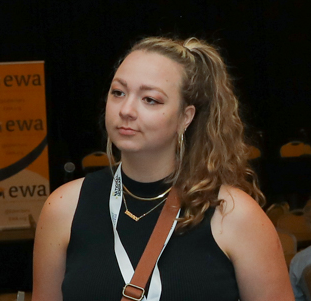Whether it’s parsing through pages of convoluted datasets or thinking of new ways to approach a story, we all get by with a little help from our colleagues and friends.
Reporters Jason Gonzales of Chalkbeat Colorado, Elissa Nadworny of NPR, and Chris Quintana of USA Today shared insights and tips on how they tackled some of their most recent higher education stories during EWA’s 76th National Seminar: Looking Back, Moving Forward last June.
Here’s how they covered students in rural Colorado, a California prison and the U.S. military.
Look for Who Is Doing It Right in Rural Higher Education
Colorado is one of the most educated states in the nation, yet there are still large gaps in the Centennial State’s educational attainment, especially among its residents of color and those living in rural counties.
Gonzales, a Colorado native, started his reporting trying to better understand the state’s higher education disparities. He ultimately spent six months reporting on how one tiny rural town built a pathway to college for its high school graduates.
After reviewing data showing which counties had the most college-going students, Gonzales discovered Fowler, a town that consistently sends the majority of its graduates to college each year.
Fowler became the main focus of Gonzales’ story, showing how rural communities can create pipelines to college. Gonzales said choosing to look at who was doing it right, rather than only focusing on challenges and failures, was intentional and set the tone for his reporting.
“Oftentimes, when I go to the lead state legislator and talk to lawmakers, they talk about this as, ‘Hey, you never focus a positive light on the things that we’re doing. We have a lot of success stories in rural Colorado, but we’re treated like we don’t have anything,’” Gonzales said. “So we didn’t want to go into this as a deficit. We want to go into this as, ‘OK, what can we learn from rural Colorado, and what lessons can be taken from that?”
Readjust as the Story on College in Prison Changes
Before federal law changed in July, restoring Pell Grant access to people in prison, Nadworny and her colleagues at NPR began working on what would become a two-year reporting project following incarcerated people in California trying to obtain bachelor’s degrees.
The biggest hurdle to her reporting? Access.
Not only can navigating a state’s prison system be difficult as a journalist, Nadworny said it can be hard to get into these classrooms without trust from administrators. Her access changed as new wardens came in with different priorities than their predecessors.
Access to incarcerated students can also be a challenge, which can be further complicated if they are transferred to different institutions or get released early. Those factors aren’t just frustrating for journalists, but especially for students.
“There’s a lot of hiccups to actually completing a certificate or degree,” she said.
Those hiccups, however, can lead you to a different story to tell, Nadworny said. That’s what happened during her reporting. She started with 11 men and ended up homing in on three who were released early due to the pandemic.
While it can be frustrating, her challenges in reporting helped shape the story into something new.
“The story changed as we were recording it because it now became a story about college in prison but also a story about what happens when you get released before you finish your degree and what support do you need,” Nadworny said.
Find U.S. Military Experts Who Already Know What You Need
There is an abundance of publicly available data for journalists to use –– if they can understand it, that is.
Quintana’s reporting focused on postsecondary institutions that exploit GI Bill funding. He found decades worth of data from the U.S. Department of Education and needed to parse through it.
As Quintana determined what he was looking for, he also reached out to people who were doing similar work.
Quintana connected with Brett Herda, an expert who was developing a tool to help veterans verify which programs would give them the greatest return on their investment. (Veterans are also attracted to higher education programs that offer flexibility and online coursework due to their professional and personal responsibilities, Quintana’s reporting shows.
Herda was helpful in initially figuring out how to check the data, Quintana said. But Quintana didn’t stop there. He reached out to his network of sources to see who had any familiarity with insurance benefits.
He found a group called Veterans Education Success, which helps veterans and their families further their education and protects the integrity of the GI Bill and other similar federal programs.
Quintana brought the data to the team and asked members to examine his work to see if it checked out against what they had found.
“I was able to share it with those folks and say, ‘Hey, I want to just make sure that this source isn’t leading me astray or that we haven’t done, like, mathematical malpractice,’” Quintana said.
The team didn’t find any issues with the data or the math. All in all, the experts Quintana worked with, he said, gave him the confidence to keep reporting his hypothesis.


